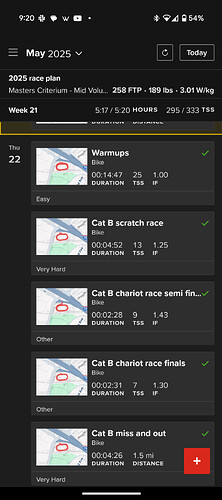I do weekly race nights at my local velodrome. On a given race night everyone warms up and then each category will do three races of different formats.
All of the races are relatively short compared to most bike races (anywhere from 15 minutes for a longer race down to 2 minutes for a match sprint), but they’re pretty high power the whole time.
When I’m planning our my race calendar I don’t put 3 race events per night (it feels excessive and is kind of a pain to do in the UI  ), I’ll put one race event on the calendar for the whole night.
), I’ll put one race event on the calendar for the whole night.
The thing is I was reading a TR blog about tss to try to understand it better and how it’s used for workout planning. Looking back I can see that when I add up the tss scores for the warmup and all of the races on a given race night the total TSS typically comes out to around 50 to 60. E.g.
I had been putting the tss on future race events as 100 because it’s track racing which is pretty much all out  but now I’m wondering if I’ve been throwing my workout plans off bc the TSS is typically half that (and now that I’m looking at it the duration is longer which I know now also factors into things).
but now I’m wondering if I’ve been throwing my workout plans off bc the TSS is typically half that (and now that I’m looking at it the duration is longer which I know now also factors into things).
So, should I be setting my TSS for future events to 50~60? Should I be making multiple events per night? Should I average out the sum duration of all of the races for a typical race night and use that for the planned event duration?
I know after the races adapting training looks at what actually happened and adjusts from there, but I want to have a good forecast of weeks to come.
Physiologically, TSS isn’t well suited to quantifying the stress on your body for this kind of effort. It is much better for threshold and below efforts, since TSS is based off FTP and FTP is good for those zones.
But when you start going above FTP, which is exactly what track sprints are all about, there’s a lot of variation between people on where there zones begin and end as percentages of FTP.
I don’t know what the best way of informing the TR algorithms of your planned workouts is, but I do know that I would be thinking of these races (and practice) as equivalent to VO2max training. In other words, the fatigue is very high, regardless of the metrics, and you need to be careful not to overdo it. Pay close attention to how you feel and err on the side of caution.
1 Like
Hey again @cschmitz 
When applying your Events to your training plan, you can add one event or multiple events on the same day. I would probably apply one as is easiest, plus, as you mentioned, the training plan will take into account all the data that gets uploaded per effort.
As far as the TSS goes, this is estimated TSS, so it’s not going to throw off the system if you’ve applied 100 vs. 50. Same thing goes for the duration. But if you want to fix the upcoming events, you’re most welcome.
What’s most important when adding your events is labeling them as A, B, or C Events because that will determine how the plan is built around them. More info here: How to Add A, B, and C Events to Your Calendar
1 Like
Ok cool good to know. Is it fair to say that if my future race event duration and TSS values are closer in estimate to what the event will actually be the workouts planned around it are less likely to be changed by adaptive training after the actual race data comes in?
I know there’s always a chance that adaptive training will change things up since that’s the point of the feature, but I like looking ahead to get a sense of what the next week or two is going to look like, so having a predicted plan that is less likely to change drastically is appealing. I’d been seeing somewhat large fluctuations in the adapted workout suggestions which is fine, but it would be cool if I could give more real event expectations so the ML had an easier time planning things out.
@cschmitz, the plans layout should not change drastically after you complete an event and the new TSS/duration is calculated in.
A plan’s adaptations come in the form of what you’ve mentioned as fluctuations in the adapted workout suggestions to meet you at your current fitness level and red/yellow days suggestions by our fatigue management system.
![]() ), I’ll put one race event on the calendar for the whole night.
), I’ll put one race event on the calendar for the whole night.![]() but now I’m wondering if I’ve been throwing my workout plans off bc the TSS is typically half that (and now that I’m looking at it the duration is longer which I know now also factors into things).
but now I’m wondering if I’ve been throwing my workout plans off bc the TSS is typically half that (and now that I’m looking at it the duration is longer which I know now also factors into things).
